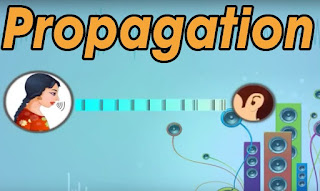Lesson Plan of Propagation of Sound General Science Grade IV
Lesson Plan of Propagation of Sound
General Science Grade IV
Students’ Learning Outcomes
·
Demonstrate that sound can
travel through solids, liquids and gases but can’t travel through vacuum.
Information for Teachers
·
The sound we hear is carried
by the vibrating air.
·
If there is no air in
surroundings of a vibrating object, the sound can’t be heard, e.g. in outer
space or in vacuum.
·
Sound vibrations can also
travel through solids and liquids, e.g. metal and water.
Material / Resources
Table, alarm clock, paper bag, plastic
container, metal can, wooden block, plastic bag, water tube, two steel spoons,
round bottom flask, bunch of keys, thread, cork, burner, textbook
Worm up activity
(Expected response: Solid,
liquid and gases)
·
Ask them what the states of
table, water and air are.
·
Then introduce today’s topic,
how sound travels through solids, liquids and gases.
·
Ask the students how they
hear different sounds around them, from a loudspeaker or a music player.
·
Ask how these sounds travel
and spread all around and reach their ears.
(Expected response: Through
air)
·
Ask one student to put
his/her ear on the table.
·
Ask another student to tap
the table with his fingers.
·
Ask the student, put ear on
the table, does he/she hear some kind of sound.
·
Ask the students: Does sound
travel through solids?
(Expected response: Sound can
travel through solids)
Development
Activity 1
·
Ask students: Do you hear the
clock ringing?
·
Now put the clock in a
plastic container and close its mouth tightly.
·
Ask students: Do you hear
clock ringing now?
·
Put the clock in a metal can
and close it tightly and ask do they hear any sound.
·
Ask them: Can sound travel
through paper, plastic and metal?
·
Conclude by mentioning that
sound can easily travel through solids e.g. paper, plastic and metal.
Activity 2
·
Show the students a tub full
of water.
·
Ask a student to bring his/her
ear close to the water tub.
·
Ask another student to hit
two steel spoons together under water.
·
Then ask do you hear any
sound? Does sound travel through water?
Activity 3
·
Take a glass flask, with some
water in it. As a student to tie a bunch of keys with a thread. Ask him/her to
pass the thread through a crock and suspend the keys inside the flask by
fitting the cork on the mouth of flask. Shake the flask. Ask the students weather
they hear the sound of keys.
(Expected response: Yes)
·
Now ask a student to heat the
flask after removing the crock. When water starts boiling and flask is filled
up with steam, ask him/her to turn off the burner and again fit the cork
tightly on the mouth of the flask. Leave the flask to cool down. When all the
steam has condensed into water, ask a student to shake the flask again. Ask the
student do they hear although the keys are shaking. Ask the students why it is
so?
·
Now explain that when water
was boiled, the air inside the flask was replaced but the steam. On cooling,
the steam changed into water and vacuum was produced in the flask. Sound can’t
travel through vacuum. Sound requires a medium for its propagation.
Sum up / Conclusion
·
Ask the students what they
have learnt about sound in this lesson. Conclude their answers by writing on
the board.
v Sound can travel through solids.
v Sound can travel through liquids.
v Sound can travel through gases.
v Sound can’t travel through vacuum.
v Material medium is required to carry sound from
one place to another.
Assessment
·
Ask the following question
verbally at the end of lesson.
v How does the sound get to your ears from
someone talking?
v Which materials can sound travel through?
v Why sound can’t travel through vacuum/
v How does sound travel when you have a
conversion with your friends
Follow up
·
Ask the students to think
about what it is like to hear things under water.








Comments
Post a Comment